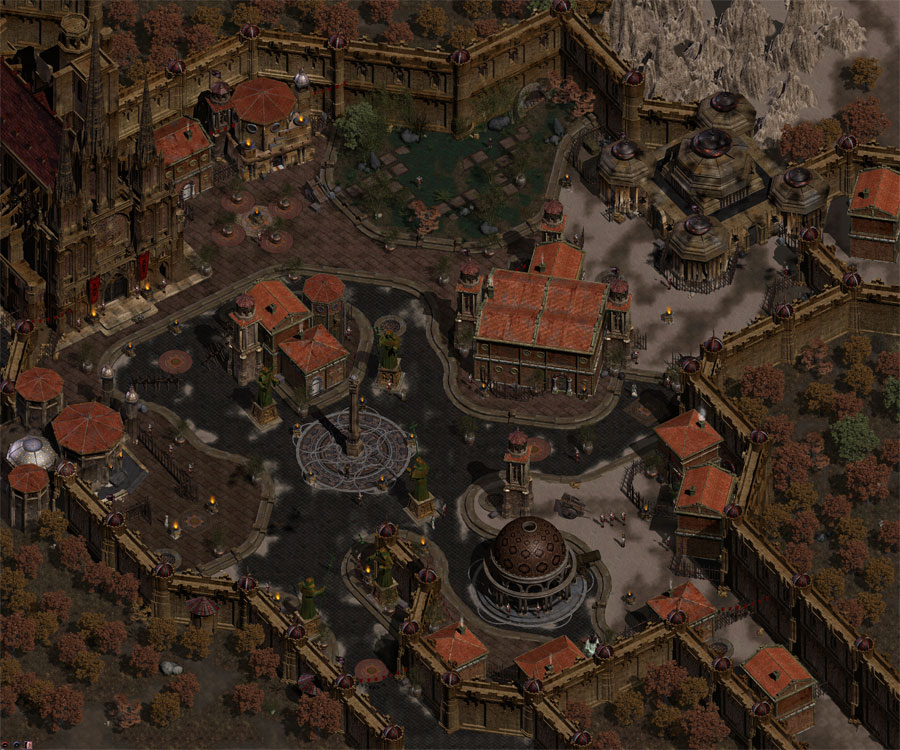Echoes of Brilliance: Lionheart's New Barcelona Evokes Fallout and Baldur's Gate
Black Isle Studios' frugal CRPG finale featured an uncut gem of a city

Ah, New Barcelona.
Its dark gold walls and red-tiled roofs remain a sight of splendor.
With Eurogamer celebrating Video Game City Week, I chose to reminisce about Black Isle Studios' last hurrah. Lionheart: Legacy of the Crusader (2003) wasn't a glorious successor to the compelling experiences of Fallout and Baldur Gate. Budget issues and a host of other problems held it back from CRPG greatness.
18 months to build on Baldur's Gate's legacy? Preposterous.
But one uncut gem made it: the city of New Barcelona.

Lionheart starts off by retconning the Third Crusade (12th century). Richard the Lionheart's massacre at Acre was now used for a ritual that tore the fabric of reality.
Magic invaded the world, giving the Spanish "witch hunts" fresh purpose.
Tasked with stopping a villain from reopening the dimensional rift, you start off in the 16th century with a spirit ally. Specifically, in a slaver pit. A quick escape later, you're dropped off in Renaissance-era New Barcelona, courtesy of Leonardo DaVinci (yes, the DaVinci).
Despite the wartime preparations against England, New Barcelona isn't armed to the teeth. Except for its comically overpowered city guards.
Lionheart is at its strongest within the walls of the famed city, featuring a degree of freedom akin to today's open-world titles. Except for the no-magic rule. Throw a fireball by accident and watch the city guards toss you into prison.
Step outside their field of view, however, and the rules no longer apply.
This melting pot of historic figures and cultures offers a surreal setting brimming with potential. Three districts with rival factions, bizarre quests, and memorable level designs await you.
Wait till we get to the species war down in the sewers.

Districts distinct in depiction
New Barcelona is split into three districts: the Gate District, Temple District, and Port District. Each district offers a glimpse into the layers of New Barcelona's citizens. And that's before you step into the spacious sewers and the alternate dimension where the Wielders reside.
The Gate District greets you as you enter and sits between the other two districts.
While this district lacks the splendor of the Temple district and the worn-out feel of the port, its characters introduce you to all the major factions in the city. The Temple district houses several historic figures alongside the headquarters of two major factions: the Knights Templar and the Inquisition.
Next to it, you'll find Cervantes prancing about as he speaks of"La Bestia" and an unassuming sewer entrance that opens up to wererats, thieves, and lava trolls sitting on relics and questlines.
The Port District reeks of intrigue and fishermens' nets.
Its tavern is home to veiled conspiracies, drunk patrons, and a good time. Assassinations and murder mysteries (cough, Guy Fawkes) meet you on arrival. You'll find DaVinci and Shakespeare's homes in the Port District as well, always up for granting and resolving quests.
But not every building houses glory and spectacle.
Under the sheen of Lionheart's historic figures and exotic workplaces lie the stories of common people. A man selling potatoes. A fisherman who buys monster skulls. A Daeva (Persian demon), cramped in a human home, relishing her human meal. There's always a quest lurking around the corner.
New Barcelona's more exhaustive quests are offered by its residing factions.

Clans of strong faith and stronger resolve
You'll encounter four primary factions during your time in New Barcelona: noble Knights Templar, narrow-minded Inquisitors, prosecuted Wielders, and the foreign Knights of Saladin. While Saladin's side only lets you join as an honorary member, all four factions offer you a maze of quests to rise through their ranks. Joining one means that you might miss out on some faction-exclusive quests (cue the replayability horn).
The factions make for some interesting dynamics, with considerable rewards for their quests. Unfortunately, faction rivalries aren't explored enough in Lionheart.
Down in the sewers, wererats and thieves make you pick between their questlines in a bid for sewer supremacy. You don't get to turn into a wererat. But you do get to court the thief guild master.
She robs you in your sleep. And you get to rob her too.
While you do meet several races later, Barcelona's ensemble was the studios' best work. The grotesque yet humorous goblins, the titans' fading memories, and how the multiple endings tie up loose ends are noteworthy but they seldom hit New Barcelona's high notes.
And while locations like Montserrat and Montaillou offer their fair share of adventuring, it's evident that Lionheart's dev machine was running out of steam.

You are but an instrument
Fallout's S.P.E.C.I.A.L. attributes (Strength, Perception, Endurance, Charisma, Intelligence, Agility, and Luck) do most of the heavy lifting in Lionheart.
They help steer conversations as well as the flow of combat in the game. Instead of a class-based system, perks, skills, and racial traits (picked in the prologue) round out your character's toolbox. The right numbers can help tackle conversations, survive battles/traps, and obtain rare loot.
Heck, build enough resistance to disease, and disease attacks heal you instead.
Pick claws instead of traditional weapons and you'll be treated differently by the populace, thanks to severe blows to your persuasion skills. The possibilities ensure that no run-throughs are entirely the same.
The title's Diablo-esque hack-n-slash ambitions, while nuanced and exciting at first, outstay their welcome once you leave New Barcelona. The first half made me wonder, "What if they kept the momentum going?"
The game's sloppy second half meant that I never got to see its epilogue as a kid.
Before Xbox Game Pass and Steam sales, gamers had to wring every penny of value out of video game purchases. And in that regard, Lionheart presents one with a platter of possibilities. But losing its artistic vision and attention to detail halfway through the narrative was a recipe for disaster.
It's no surprise that Lionheart's flame wavers once you leave New Barcelona.
I'll never forget the dead man lying outside its imposing walls. Should I report the goblins responsible or do I side with them? Choices, choices.
Nostalgia might be why I disagree with Lionheart's mediocre critical reception. The same two-edged sword is also why I can't forget New Barcelona. Its people and the events that I shaped remain a core memory, one that no demon can purge.
